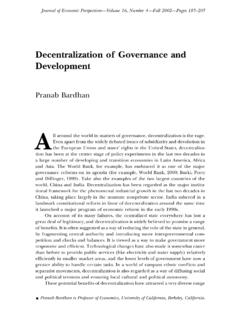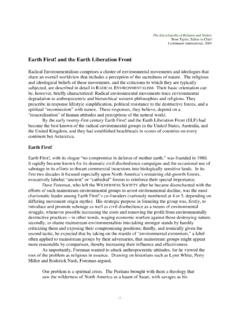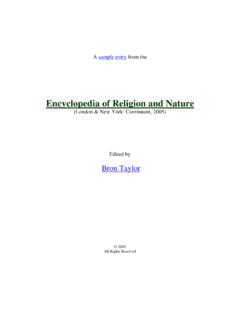Transcription of Re-visiting Ursula Le Guin’s The Dispossessed : Anarcho ...
1 , June 2007. Re-visiting Ursula Le Guin's The Dispossessed : Anarcho - Taoism and world Resource Management. By Samar Habib I called it an ambiguous utopia . I think it's a perfectly natural step to go from Taoism to anarchism. That's what I found myself doing [in The Dispossessed ]. They are definitely related, they appeal to the same type of person, the same bent of Ursula K. Le Guin is one of the most influential science fiction and fantasy writers of the twentieth century and is easily the most prolific female author we have seen in relation to these, often male-dominated, genres. Born in 1929 in Berkeley, California, Le Guin has led a somewhat parochial lifestyle and has rarely ventured away from the West Coast.
2 Since her return from Paris to live in Portland, Oregon, in Her works received numerous awards and honours and they continue to be the subject of critical and analytical scrutiny across the academy. The series of novels that take place within her Hainish Universe 3 yield complexity and insight beyond the scope of most science fiction writers. The Dispossessed : An Ambiguous Utopia, which won both the Hugo and Nebula Awards in 1975, was Le Guin's last Hainish universe novel to be published, but in the chronology of that world it is the first story to occur along the timeline. However, it is not this intricacy and combination of geographically plausible worlds and timelines that have made The Dispossessed a classic, but rather the unassailable philosophical contribution to Utopian discourse that it has made and continues to make.
3 Le Guin had managed to imagine and put in motion an alternative economy and styles of living which could work and whose inhabitants were all equally stripped of an infrastructure that would enable the power-hungry to exercise that power, once obtained, on others. But this utopian world did not prevent the existence of, or annihilate, such individuals. Take the character Sabul for instance, in his attempts to suppress fresh intellectual ideas that disprove his own,4 or that incidental character, Desar the mathematician, who compulsively hoards and accumulates material for himself, despite the free availability of amenities and paraphernalia (133-134). Such individuals continue Habib: Re-visiting Ursula Le Guin's The Dispossessed 334.
4 , June 2007. to exist but they are disabled from inflicting themselves absolutely on others. There is a utopia even in this simple idea of de-centralizing power, of turning governments into administrations of things not people. Recently, an anthology of thoroughly researched critical essays on The Dispossessed was published, but there was an omission of a rigorous treatment of what Le Guin saw at the time as a relationship between anarchist theory and Although articles on both anarchism and Taoism in relation to the novel exist,6 there has not been a serious attempt to consider the interrelations of these modes of thought and how they are represented in the novel. In this article my intention is to explore Le Guin's imperfect Utopia and to expose the intertextual influences of Taoism and anarchist theory on Le Guin's profound novel and vision in the hope of filling the hiatus which currently exists in this area.
5 The Background to the Story The story of The Dispossessed begins with its hero, Shevek, boarding a shuttle from a planet called Anarres to another satellite planet called Urras. The ancestors of the inhabitants of Anarres came from Urras, some sixteen hundred years prior to the timeline of the text, after a revolutionist by the name of Odo led an insurrection against the government system of her nation. The anarchic theory of Odonianism gathers support and momentum after its founder's death, so that a small group of internationalist, Urrasti inhabitants, identifying themselves now as Odonians, are given the means to colonize Urras's arid, desert-like moon. With this opportunity the Odonians set out to create a society which observes the paradigm of anarchic political theory.
6 This theory of Odonianism, is not to be mistaken, as Ursula Le Guin tells us, with the bomb-in-the-pocket stuff, which is terrorism [or] the social-Darwinist libertarianism . of the far right; but anarchism, as prefigured in early Taoist thought, and expounded by . Kropotkin, Goldman and Goodman. 7 Odonianism then, is extrapolated from the political theory of anarchism that was developed in the late nineteenth century by European thinkers such as Peter Kropotkin, Emma Goldman and Michael Bakhunin. Furthermore, Odonianism is, as Le Guin indicates in several interviews, a combination of Taoist thought and anarchist theory. Habib: Re-visiting Ursula Le Guin's The Dispossessed 335.
7 , June 2007. From Taoism to Anarchism and Back It is believed that Taoism was born in the first century (this is uncertain), out of the writings and teachings of Lao Tzu and his disciple Chuang Tzu. Taoist thought creates a consciousness of the world that encompasses every distinct thing and being into an unsegmented whole. Lao Tzu writes: There is something that contains everything. Before heaven and earth it is. Oh, it is still, unbodied, all on its own, unchanging . Not knowing its real name, we only call it the Way. 8 This unsegmented whole, in another translation and interpretation of the Tao-Te-Ching, is said to be the all-changing changeless which is also being in itself.
8 9 Therefore, in Lao Tzu's ontological projection, reality is oddly static but in this stasis and precisely because of it, inexhaustible change and new life is possible. The stasis is called ho', roughly meaning structure' (in Shevek's temporal physics this is the cycle of time', in Odo's social theory it is called the ends') and the inexhaustible spirit of change is called k'ai, which means expansion' (Shevek calls this linear time', Odo calls it the means').10. Deleuze and Guattari's 1933: Micropolitics and Segmentarity 11 offers a demonstration of this conception of the human world as oscillation between the expansive and the static. The main stipulation for Deleuze and Guattari in their essay, is that laws and states (or communities with customary law) are facts of human existence, changeless, part of the structure that Taoism refers to as Ho.
9 Deleuze and Guattari focus on the tensions that exist between states and individuals (or customary law and the individuals in non- centralized societies) as object-specific examples of the Taoist perception of the changeless'. In the field of theoretical political science (which is what Deleuze's philosophy is in this context) aspects of Taoism can be used to theorize the human world . However Lao Tzu does not specify what is part of the structure and what is part of k'ai, but man-made laws are not seen as part of the cognition that attempts to comprehend the Way. For this, there is a simple reason in Taoism. To create a law one needs the knowledge of the difference between good' and bad', of course this is relative to the creators of the Habib: Re-visiting Ursula Le Guin's The Dispossessed 336.
10 , June 2007. law. Within the all-changing-changeless there are two things, one origin, but different in name, whose identity is mystery. Mystery of all mysteries! (Lao Tzu, 3). The difference between, for example, the north pole and the south pole is metaphysically impossible, however people are surer of the difference between good and bad. From the all-changing-changeless polarities emerge that humans think they are capable of distinguishing between. This distinction, in Taoist thought is an illusion, which enlightened ones overcome. On the basis of the uncertainty of all knowledge a Taoist cannot conceive of a law, since a law assumes one certainty or another. Taoism therefore is more accurately related to a political theory which admits indeterminacy, lawlessness and constant change, rather than to a political theory that finds states, laws and rigid authority as unchangeable facts of human being.
![The Handmaid's Tale[1] - Nebula](/cache/preview/b/1/f/8/5/0/0/b/thumb-b1f8500ba7b72b7af7a7b5ba2fa73a2d.jpg)








